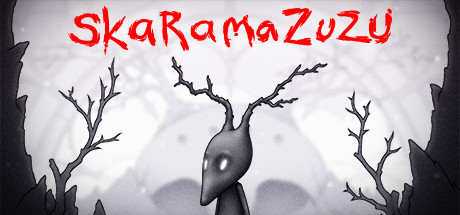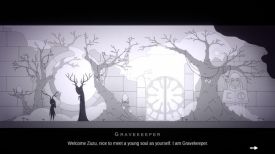|
By flotsam
Skaramazuzu
Bleeding Moon Studio/Iphigames
This is the story of our titular character Ė Zuzu as
Ďheí prefers to be known Ė a lost soul summoned (guided actually) by the
mysterious Master to somewhere between being dead and being alive. He is
there because he wanted to be, although that seems like news to him.
Sent further into the void, if he can activate four Orb Keys and gets to
its Ďendí he might find himself, and who knows what else along the way.
Zuzuís world is a 2D black-and-white delight. There
is a gothic nature about the pale and even paler construct, the inky
blacks all the more prominent as a result. So too there is a rich
simplicity in each scene, and a sharp starkness highlighted by the hand
drawn line drawings. Visually it reminded me a bit of Birth, and it
appealed to me enormously.
The game world is explored by moving left and right
through the various screens, and occasionally in other directions.
Arrows will appear as you approach to indicate an exit point into a new
screen, and elongated exclamation marks will pop up to indicate
something to interact with. Your options at those points are talk or
interact, and Zuzu likes to talk. Talking to, or to himself about,
inanimate objects will tell you more about the nature of Zuzu, so donít
dismiss that option.
The puzzling is gentle, some of it being
observational with a bit of interpretation thrown in, the bulk being
finding and using inventory items and having the appropriate
conversations to trigger the way forward. I donít think I ever had more
than three inventory items at any one time, and usually only one. You
donít examine them or combine them, rather you can just choose to use
them through the interact option.
Uncovering information through the conversations will
identify your various objectives. These are automatically recorded in
your journal, and I gathered a lot more than I completed over the first
half of the three hours the game took me, so I appreciated the very
organised way they were collated in the journal. A little message and a
pencil animation will indicate another objective has been added.
The game is narratively way more involved but in
short, the various things you need to get closer to activating the Orbs
are in the possession of others, who will give them to you in return for
something else. Which might well involve doing one or more things for
one or more others, much like a questing RPG. So you will go back and
forth, finding things and using them to achieve things in order to open
up information or other areas to continue your efforts.
It isnít hard, and I think the only time I wondered
what to do next was after having activated an Orb. Without spoiling
things, I felt the need to re-explore in order to see what might have
changed or who might now know something more. Reasonably quickly I
uncovered something which, when plugged back into what I already knew,
moved me forward.
The activation of the first Orb took me about half my
game playing time. The next three took the same amount of time combined.
Some of that is down to the fact that certain elements repeat, and that
once you have worked out the answer the first time the mechanics are the
same from then on, but its also a product of the fact that you do much
more uncovering rather than solving in the initial half of the game.
Apart from that sameness, my only other grumblement
was that the game will tell you at the start that it autosaves so donít
do anything when the particular symbol appears. What it wonít tell you
is that exiting to the main menu also saves the game. I spent the first
90 minutes waiting for the save symbol to appear, not realising I could
exit long before I wanted to. Which I appreciated once I worked it out,
but which happened completely by accident.
There is no spoken word, or rather there is but you
canít understand it. Gibberish is the stock in trade, and it is really
well done. While subtitles will tell you what is being said, everything
about the Ďvoicesí is a treat. The mood, the tone, the emotion, even the
nature of the character all come through in the strange noises. Zuzu
stands out, a sing-song cadence just adding to the reasons why you canít
but help like him. Listen to him say awwww and tell me you donít agree.
Zuzu moves and interacts with the game world courtesy
of the keyboard or a gamepad (you can put away your mouse). Much of each
screen is static, but there is sufficient movement going on to bring
each one to life. Not too much though, which is in keeping with the
nature of where this place is. A (mostly) ethereal underlying soundtrack
and the ambient sound further enhance the overall mood.
I played it straight through and enjoyed it a lot.
I played on:
OS: Windows 10, 64 Bit
Processor: Intel i7-9700K 3.7GHz
RAM: Corsair Dominator Platinum RGB DDR4 32GB
Video card: AMD Radeon RX 580 8192MB
GameBoomers Review Guidelines
April 2024
design copyright© 2024
GameBoomers
Group
 GB
Reviews Index GB
Reviews Index |




